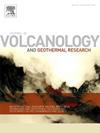Impact of cooling rate on rheology and emplacement dynamics of basaltic lavas: Insights from the January 2024 Sundhnúksgígar eruption (Iceland)
IF 2.3
3区 地球科学
Q2 GEOSCIENCES, MULTIDISCIPLINARY
Journal of Volcanology and Geothermal Research
Pub Date : 2025-06-30
DOI:10.1016/j.jvolgeores.2025.108400
引用次数: 0
Abstract
The 2023–2024 eruptions at Sundhnúksgígar in Iceland produced tholeiitic basaltic lavas that traveled at high velocities, affecting vast areas. Under such conditions, disequilibrium crystallization can play a fundamental role in modulating the lava flow dynamics and inundation capacity. To investigate this phenomenon, we carried out a comprehensive rheological characterization of the Sundhnúksgígar basalt, analyzing both the liquid phase and the crystal-bearing suspensions under disequilibrium conditions (cooling rates ranging from 0.1 to 10 °C/min) and near-equilibrium conditions (at fixed temperatures between 1242 and 1180 °C). Our results show that the cooling rate critically influences the extent and timescale of disequilibrium crystallization, thereby shaping the rheological evolution of the melt, leading to distinct deformation response of the crystal-bearing magmatic suspension. Compared to other basalts erupted worldwide, the Sundhnúksgígar melt exhibits two main features: i) an exceptionally low rate of viscosity increase induced by crystallization and ii) the ability to crystallize even at the highest cooling rates applied during the experiments. These characteristics may contribute to enhancing the efficiency of external crust formation, limiting heat loss from the inner portion of the lava flow, which consequently cools more slowly. Thermal insulation effects reduce the rate of viscosity increase during lava emplacement, a key factor in determining lava flow inundation potential. Our findings underscore the critical role of disequilibrium crystallization in governing the rheological evolution and emplacement dynamics of basaltic lavas, offering new insights into lava flow behavior.
冷却速率对玄武岩熔岩流变学和就位动力学的影响:来自2024年1月Sundhnúksgígar火山喷发(冰岛)的启示
冰岛Sundhnúksgígar火山在2023年至2024年的喷发产生了高速移动的拉斑玄武岩熔岩,影响了大片地区。在这种条件下,不平衡结晶可以在调节熔岩流动力学和淹没能力方面发挥根本作用。为了研究这一现象,我们对Sundhnúksgígar玄武岩进行了全面的流变学表征,分析了液相和含晶悬浮液在不平衡条件下(冷却速度从0.1到10°C/min)和近平衡条件下(固定温度在1242到1180°C之间)的变化。研究结果表明,冷却速率严重影响不平衡结晶的程度和时间尺度,从而影响熔体的流变演化,导致含晶岩浆悬浮液的明显变形响应。与世界范围内喷发的其他玄武岩相比,Sundhnúksgígar熔体表现出两个主要特征:1)结晶引起的粘度增加速度极低;2)即使在实验期间使用的最高冷却速率下也能结晶。这些特征可能有助于提高外部地壳形成的效率,限制熔岩流内部部分的热量损失,从而使其冷却得更慢。保温效果降低了熔岩就位时粘度的增加速度,这是决定熔岩流淹没势的关键因素。我们的发现强调了不平衡结晶在控制玄武岩熔岩流变演化和就位动力学中的关键作用,为熔岩流动行为提供了新的见解。
本文章由计算机程序翻译,如有差异,请以英文原文为准。
求助全文
约1分钟内获得全文
求助全文
来源期刊
CiteScore
5.90
自引率
13.80%
发文量
183
审稿时长
19.7 weeks
期刊介绍:
An international research journal with focus on volcanic and geothermal processes and their impact on the environment and society.
Submission of papers covering the following aspects of volcanology and geothermal research are encouraged:
(1) Geological aspects of volcanic systems: volcano stratigraphy, structure and tectonic influence; eruptive history; evolution of volcanic landforms; eruption style and progress; dispersal patterns of lava and ash; analysis of real-time eruption observations.
(2) Geochemical and petrological aspects of volcanic rocks: magma genesis and evolution; crystallization; volatile compositions, solubility, and degassing; volcanic petrography and textural analysis.
(3) Hydrology, geochemistry and measurement of volcanic and hydrothermal fluids: volcanic gas emissions; fumaroles and springs; crater lakes; hydrothermal mineralization.
(4) Geophysical aspects of volcanic systems: physical properties of volcanic rocks and magmas; heat flow studies; volcano seismology, geodesy and remote sensing.
(5) Computational modeling and experimental simulation of magmatic and hydrothermal processes: eruption dynamics; magma transport and storage; plume dynamics and ash dispersal; lava flow dynamics; hydrothermal fluid flow; thermodynamics of aqueous fluids and melts.
(6) Volcano hazard and risk research: hazard zonation methodology, development of forecasting tools; assessment techniques for vulnerability and impact.

 求助内容:
求助内容: 应助结果提醒方式:
应助结果提醒方式:


